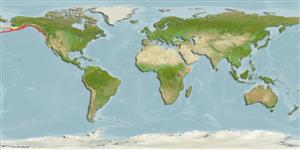Teleostei (teleosts) >
Perciformes/Scorpaenoidei (Scorpionfishes) >
Sebastidae (Rockfishes, rockcods and thornyheads) > Sebastinae
Etymology: Sebastes: Greek, sebastes = august, venerable (Ref. 45335); proriger: From the Latin prora and gero, meaning 'bow' and 'to bear' (Ref. 27436).
More on authors: Jordan & Gilbert.
Environment: milieu / climate zone / depth range / distribution range
Ecology
Marine; bathydemersal; depth range 12 - 425 m (Ref. 6793), usually 183 - 274 m (Ref. 27437). Deep-water; 66°N - 32°N, 177°E - 116°W
North Pacific: Pribilof Canyon in the Bering Sea and Amchitka Island in the Aleutian chain to San Diego, California, USA.
Size / Weight / Age
Maturity: Lm ? range ? - ? cm
Max length : 61.0 cm TL male/unsexed; (Ref. 27437); max. reported age: 55 years (Ref. 39247)
Dorsal spines (total): 13; Dorsal soft rays (total): 13 - 15; Anal spines: 3; Anal soft rays: 6 - 7. Head spines weak - nasal, preocular, postocular, tympanic and parietal spines present, supraocular, coronal and nuchal spines absent (Ref. 27437). Notch on dorsal fin shallow; 2nd anal fin spine is of the same length or shorter than the 3rd (Ref. 27437). Caudal fin moderately indented (Ref. 6885). Light red and mottled with olive on back, lower sides flushed with yellow; light red stripe along lateral line; lips blackened; fins red with some light green or yellow (Ref. 27437).
Body shape (shape guide): fusiform / normal.
Occur in areas where rocky reefs and steep silt-covered cliff faces meet gently sloping sand or mud bottoms (Ref. 27436). Found hovering just off the bottom or resting on a rocky perch (Ref. 27436). Viviparous (Ref. 34817). Sold as fresh or frozen fillets, together with other rockfish species (Ref. 27436). Not popular as a game fish (Ref. 27436).
Life cycle and mating behavior
Maturity | Reproduction | Spawning | Eggs | Fecundity | Larvae
Eschmeyer, W.N., E.S. Herald and H. Hammann, 1983. A field guide to Pacific coast fishes of North America. Boston (MA, USA): Houghton Mifflin Company. xii+336 p. (Ref. 2850)
IUCN Red List Status (Ref. 130435: Version 2025-1)
Threat to humans
Harmless
Human uses
Fisheries: commercial; gamefish: yes
Tools
Special reports
Download XML
Internet sources
Estimates based on models
Preferred temperature (Ref.
123201): 3.7 - 6.6, mean 5.4 °C (based on 51 cells).
Phylogenetic diversity index (Ref.
82804): PD
50 = 0.5000 [Uniqueness, from 0.5 = low to 2.0 = high].
Bayesian length-weight: a=0.01000 (0.00495 - 0.02022), b=3.09 (2.92 - 3.26), in cm total length, based on LWR estimates for this Genus-body shape (Ref.
93245).
Trophic level (Ref.
69278): 3.8 ±0.5 se; based on size and trophs of closest relatives
Generation time: 7.4 ( na - na) years. Estimated as median ln(3)/K based on 2
growth studies.
Resilience (Ref.
120179): Low, minimum population doubling time 4.5 - 14 years (K=0.15-0.18; tmax=55).
Fishing Vulnerability (Ref.
59153): High vulnerability (58 of 100).
🛈
